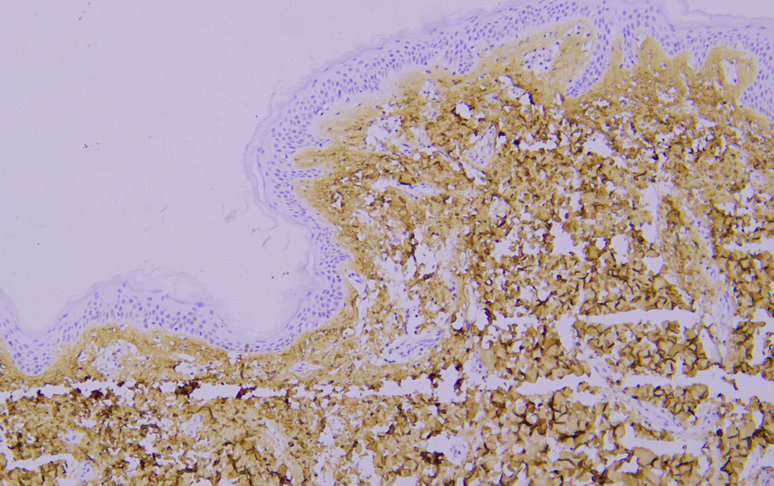Collagen Type III (ABT192R) rabbit mAb (Ready to Use)
- Catalog No.:YM7265R
- Applications:IHC
- Reactivity:Human;
- Target:
- Collagen III
- Fields:
- >>Platelet activation;>>Relaxin signaling pathway;>>AGE-RAGE signaling pathway in diabetic complications;>>Protein digestion and absorption;>>Amoebiasis;>>Diabetic cardiomyopathy
- Gene Name:
- Collagen alpha-1(III) chain
- Protein Name:
- Collagen alpha-1(III) chain
- Human Gene Id:
- 1281
- Human Swiss Prot No:
- P02461
- Immunogen:
- Synthesized peptide derived from human Collagen Type III AA range:100-200
- Specificity:
- This antibody detects endogenous levels of Collagen III
- Formulation:
- The prediluted ready-to-use antibody is diluted in phosphate buffer saline containing stabilizing protein and 0.05% Proclin 300
- Source:
- Monoclonal, Rabbit IgG1, Kappa
- Dilution:
- Ready to use for IHC
- Purification:
- Recombinant Expression and Affinity purified
- Storage Stability:
- 2°C to 8°C/1 year
- Other Name:
- COL3A1
- Background:
- collagen type III alpha 1 chain(COL3A1) Homo sapiens This gene encodes the pro-alpha1 chains of type III collagen, a fibrillar collagen that is found in extensible connective tissues such as skin, lung, uterus, intestine and the vascular system, frequently in association with type I collagen. Mutations in this gene are associated with Ehlers-Danlos syndrome types IV, and with aortic and arterial aneurysms. Two transcripts, resulting from the use of alternate polyadenylation signals, have been identified for this gene. [provided by R. Dalgleish, Feb 2008],
- Function:
- disease:Defects in COL3A1 are a cause of Ehlers-Danlos syndrome type 3 (EDS3) [MIM:130020]; also known as benign hypermobility syndrome. EDS is a connective tissue disorder characterized by hyperextensible skin, atrophic cutaneous scars due to tissue fragility and joint hyperlaxity. EDS3 is a form of Ehlers-Danlos syndrome characterized by marked joint hyperextensibility without skeletal deformity.,disease:Defects in COL3A1 are a cause of susceptibility to aortic aneurysm abdominal (AAA) [MIM:100070]. AAA is a common multifactorial disorder characterized by permanent dilation of the abdominal aorta, usually due to degenerative changes in the aortic wall. Histologically, AAA is characterized by signs of chronic inflammation, destructive remodeling of the extracellular matrix, and depletion of vascular smooth muscle cells.,disease:Defects in COL3A1 are the cause of Ehlers-Danlos syndrome t
- Subcellular Location:
- Secreted, extracellular space, extracellular matrix .
- Expression:
- Colon carcinoma,Liver,Placenta,Skin fibroblast,
- June 19-2018
- WESTERN IMMUNOBLOTTING PROTOCOL
- June 19-2018
- IMMUNOHISTOCHEMISTRY-PARAFFIN PROTOCOL
- June 19-2018
- IMMUNOFLUORESCENCE PROTOCOL
- September 08-2020
- FLOW-CYTOMEYRT-PROTOCOL
- May 20-2022
- Cell-Based ELISA│解您多样本WB检测之困扰
- July 13-2018
- CELL-BASED-ELISA-PROTOCOL-FOR-ACETYL-PROTEIN
- July 13-2018
- CELL-BASED-ELISA-PROTOCOL-FOR-PHOSPHO-PROTEIN
- July 13-2018
- Antibody-FAQs
- Products Images

- Immunohistochemical analysis of paraffin-embedded human Colon. 1, Antibody was incubated at 4° overnight. 2, Citrate buffer of pH6.0 was used for antigen retrieval. 3,Secondary antibody was diluted at 1:200(room temperature, 30min).

- Immunohistochemical analysis of paraffin-embedded human Skin. 1, Antibody was incubated at 4° overnight. 2, Citrate buffer of pH6.0 was used for antigen retrieval. 3,Secondary antibody was diluted at 1:200(room temperature, 30min).



